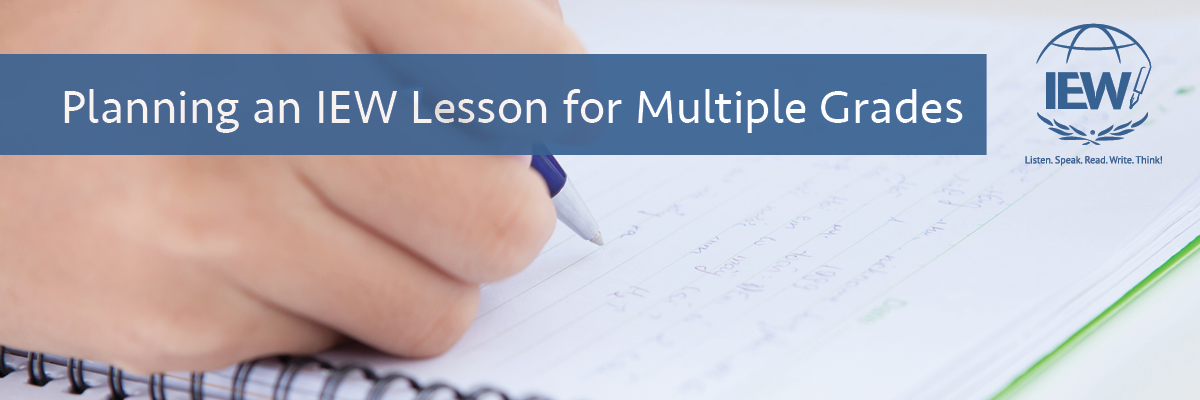
We live in a time where there are many options for educating our students. Since the pandemic more and more families have chosen to educate their children in nontraditional settings. Many of these settings include teaching children of multiple ages and abilities together, which can be overwhelming for the instructor. However, IEW’s methodology is excellent in reaching out to all spectrums of students’ aptitudes. With the right materials and a purposeful methodology, students and teachers alike will reap the benefits.
When preparing to teach several grade and ability levels, start by gathering materials. The theme-based books especially lend themselves to teaching groups of students with varying abilities. Most of these books come with Simplified Source Texts and Advanced Additions, making it easy to ensure that all students work with source texts that are at or below their individual reading level. Another tool that I find essential is the Checklist Generator, which is one of the many benefits of the Premium Membership. Since I want to ensure that each student is working with stylistic techniques at the EZ+1 pace, it is critical that each has a customized checklist. The Checklist Generator makes this easy with just a few clicks of the mouse. Having three levels of checklists—beginner, intermediate, and advanced—typically meets the needs of all the students in my class. Finally, getting writing samples from the students helps me determine which checklist to start them with. This is a great exercise to do the first week of class. An additional benefit is returning them to students at the end of the course to compare with later writing samples—they will be proud of how much they have improved! Once you have gathered these materials, you are ready to dive into the nine units.
Teaching a multi-grade class requires a deliberate methodology. When introducing a unit of structure to the students, I teach them all together using the same source, usually the source from the book. After the lesson I give them one of the three levels of checklists I have created ahead of time based on their writing samples. At this point, I give the experienced students an additional source text from the Advanced Additions to do as well. The reinforcement lessons are where you can further differentiate to meet the needs of the students. After reviewing the structural model, I teach a stylistic technique that all students practice. Even though students have customized checklists, they are still exposed to and practicing the dress-ups and sentence openers that will be added to their checklist in the future. At this point, I divide the class into groups. Sometimes I work with the beginner group, providing them as much assistance as they need. Sometimes I work with the advanced students, taking the opportunity to teach them an advanced stylistic technique or challenge them in other ways. Not wanting to leave the intermediate students out, I will also spend time encouraging and coaching them.
When it comes time to grade the students’ assignments, I use their customized checklists. It is important to keep in mind one of the Four Deadly Errors of Teaching Writing when grading: the error of overcorrecting. I make as few marks as possible, only marking the assignment enough to make it legal. I hold them accountable for grammar concepts that we have encountered in Fix It! Grammar and leave the rest, knowing that they will learn those grammatical concepts as we progress through Fix It! throughout the year. Through trial and error, I have found this methodology to be effective in my home, in co-ops, and in classrooms.
There are many benefits to planning the lesson this way. First, it meets students at their point of need through the use of customized checklists, Simplified Source Texts, and Advanced Additions. Students also learn from each other and are motivated to do their best. It benefits families as they can work together, strengthening the familial bond. Our family would have friendly competitions to determine who could use the current lesson’s vocabulary words the most in our daily conversations. Having a subject that most of the siblings can do together also makes things easier for the parents! This approach is also advantageous for homeschool co-ops. Often there are not enough teachers or students to have a writing class for each grade level. Combining grade levels makes it possible for more students to develop their writing skills. Finally, planning this way supports school teachers. Although all the students in a class may be in the same grade, they are not all performing at the same level. Differentiated instruction can be time consuming, but IEW’s philosophy and methodology enables teachers to meet the needs of each student.
Planning an IEW lesson across several grade levels is not difficult once you have the appropriate materials and employ an intentional methodology. Together, it moves teachers and teaching parents toward the goal of equipping students to be competent and confident communicators and thinkers.
by Deanne Smith
